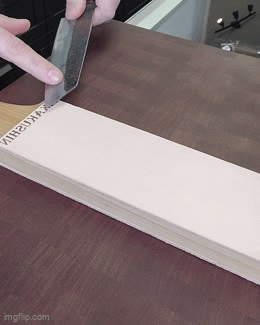NOW AVAILABLE - ENGRAVING SERVICES
NOW AVAILABLE
ENGRAVING SERVICES

When it comes to knife maintenance, three terms often come up: honing, stropping, and sharpening. As the owner of Kakushin's Knife Shop, where we provide various knife services including sharpening and repairs, it's crucial to clearly define these terms for you. Understanding the differences will help you maximize the sharpness and longevity of your knives.
Ready to dive in? Let's break it down:
Honing
Honing a knife is probably one of the most misunderstood and underestimated maintenance tasks in most homes. Associated with the honing rod, which can come in various shapes, sizes, and materials, a honing rod was not initially designed to sharpen your knives. While these days many manufacturers try to use hard abrasives to allow the honing process to remove metal (sharpen), we recommend a soft but at the same time hard Ceramic Honing Rod to keep it simple and effective.
Firstly, since a honing rod shouldn't remove metal from your knife, it means that it will never "bring back" lost sharpness. While using force and bad abrasives might give this effect, it's imperative that you use the honing rod as a maintenance tool rather than a sharpening stick once the knife is dull.
The goal of honing is to realign the micro-bevel and clean the burr of your knife preventing it from folding against itself. This process will extend the sharpness of your knife by polishing the edge and aligning it, which is why it's recommended to use a honing rod regularly, on new and even freshly sharpened knives.

If you wait too long and your knife starts becoming dull, it won't be the duty of your rod to bring it back. In fact, most times, it won't work, and you will need to jump into sharpening, which is a longer and more complex process. That being said, even with proper honing, every knife will require and highly benefit from a good sharpening.
Sharpening
Knife sharpening involves the removal of metal from the knife's primary. While frequent metal removal can compromise the optimal cutting geometry and performance of your knives, thinning becomes necessary after numerous sharpening cycles, a complex topic we'll delve into later.
The preferred method for sharpening knives is typically by hand using stones (whetstones). While there are various other methods on the market, the controlled process of whetstone sharpening prevents blade overheating and results in optimal polishing when executed correctly.
Sharpening restores the knife's edge to its ideal "V" shape, with angles varying: approximately 10-15 degrees for Japanese knives, 15-20 degrees for Western knives, and 20-25 degrees for outdoor knives.

Ideally, knives should be sharpened just before they lose their cutting performance and begin to chip- not once they are dull. This not only facilitates the task but also ensures minimal material removal, preserving the knife's original geometry for proper functionality.
Most quality knives used several times a week at home should benefit from sharpening every 12-18 months. However, some can last longer while others may need it sooner, depending on the quality of the steel, the cutting surface, and your maintenance habits, such as honing.
Stropping
Similar to honing, as discussed earlier, stropping is another highly effective process used to enhance the sharpness of your knife. It involves using a soft material such as leather to clean and polish the imperfections that have developed on your knife, significantly increasing its cutting accuracy and razor-like feel.

Compounds are available on the market as polishing additives for leather. These compounds contain extremely fine abrasives that don't visibly remove material but do perfect the edge.
In some cases, users have successfully used leather belts, newspaper or even wood to strop their knives, especially when they are stuck and on-the-go on camping, fishing, or hunting trips.
So which one is better?
Honing, stropping, or sharpening? The key is knowing when to use each process and using it properly.
All knives will require regular honing with a rod, preferably made of ceramic. Ceramic is a hard surface suitable for use on both Western and Japanese knives, especially when using the finest grit available. Incorporate honing into your routine every few meals, up to about once a week for home use. Only switch to sharpening when honing no longer extends the sharpness of your knife, whether done at home or professionally.
As a finishing touch often likened to adding additives to your car, stropping your knife will enhance its cutting power by removing fine particles from the edge generated during sharpening. Stropping can also serve as maintenance, similar to honing, on a daily or weekly basis. Keep in mind that you cannot over-strop your knives; it simply helps maintain their sharpness.
Thanks for reading and be sure to leave me a comment below!
Leave a comment